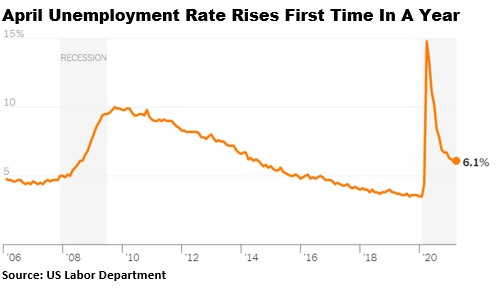One of the worst economic reports of 2021 was last Friday’s unemployment report for April from the Labor Department. The DOL reported the US economy added 266,000 new jobs last month, and the official unemployment rate ticked up mildly to 6.1%. Normally, that would not be really bad news.
This time, however, it was a major disappointment because the pre-report consensus among economists and forecasters predicted a rise of 1 million new jobs in April and a slight dip in the overall unemployment rate. Not only that, the DOL revised the March new jobs figure lower by a considerable amount.
While the March jobs number was revised lower, it was still an impressive rise of nearly 800,000 new jobs in a single month. And most forecasters believed the economy did even better in April. Not so! The weak April jobs number was a real stunner.
As a result, forecasters have been trying this week to figure out what is really going on in the economy. Was the strong March jobs number just an outlier, not likely to be repeated? Or was the low April number the outlier? As this is written, no one knows for sure, and that seems to be a really big deal in financial/investment circles.
In essence, the key question is whether the US economy has really turned around, or not?
As usual, your Editor has some thoughts on this question. First and foremost, why are we focusing so much attention on one month’s jobs report? Not only are the monthly reports often quite volatile, they are also revised significantly in subsequent months. Who knows if the disappointing April jobs number will look so bad after it’s revised a couple of times?
To begin my comments on the very disappointing April jobs report, let’s step back and look at the big picture. I think we can all agree we are living in unprecedented economic times due to the COVID-19 pandemic. As a result, monthly economic reports are going to be all over the board. Maybe we shouldn’t put too much weight on any given monthly report.
Consider that the American economy lost 22 million jobs in March and April of 2020 in the depths of the coronavirus recession. Many of those jobs have come back but we’re still 8 million jobs short of where we were before the pandemic began last year.
While the Covid-19 vaccine is now widely available, and more than half of American adults have had at least one shot, the virus is still a dangerous threat — and millions more adults still need to be vaccinated, not to mention children. The point is, we are far from done with this pandemic, and the economy is going to be unpredictable for a while longer.
Going back to the disappointing April jobs number, most forecasters point to the fact that many schools are still not open, ditto for childcare facilities, and many parents are still not able to go back to work. Also, there is the question of the generous unemployment benefits which may be keeping some workers at home rather than going back to work.
Over 60% of small businesses report in numerous surveys that they are having trouble finding workers. As a result, we can expect wages to rise in the months ahead and inflation is likely to rise as a result. But that’s another story.
The bottom line is the economic recovery is going to be rocky, and there will almost certainly be more months like March and April when job growth will surprise on the upside and downside. Try not to overreact to it.
Unfilled Job Openings Hit New Record High
US job openings surged in March to a record high, underscoring a rapid increase in labor demand as vaccinations accelerate and states reopen their economies.
The number of available positions increased to 8.12 million during the month, the highest in data back to 2000, from an upwardly revised 7.53 million in February, the Labor Department reported on Tuesday. The median estimate in a Bloomberg survey of economists called for 7.5 million openings.
The number of unfilled jobs exceeded hires by more than 2 million, the largest gap on record and evidence of current hiring challenges. Many employers say they are unable to fill positions because of ongoing fears of catching the coronavirus, child-care responsibilities and generous unemployment benefits.
The rising level of vacancies is consistent with accelerating demand as the economy reopens, with many companies trying to fill positions lost during the pandemic. Job openings increased in all regions, led by bigger monthly gains in the Midwest and Northeast.
The bottom line: Finding qualified workers is already tough and is getting even tougher, despite the fact that there are still 8 million Americans who lost their jobs in the pandemic and haven’t gone back to work.



Once the Fed stops pumping money into the economy this bubble is going to be on the downward spiral. The 10 year treasury rate hits 2% and its going too change everything.